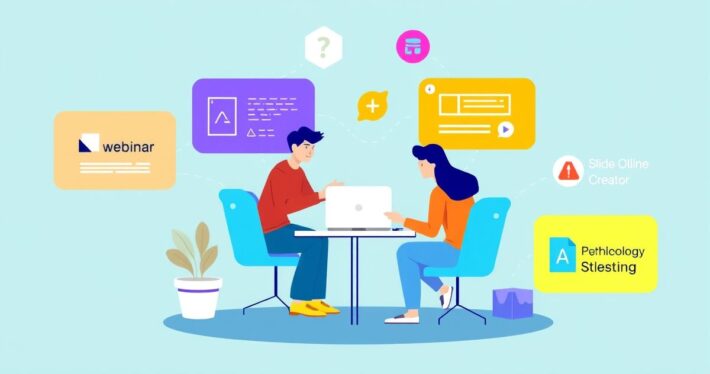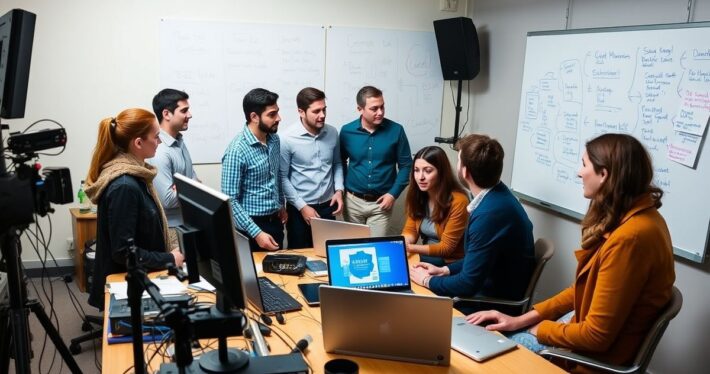Best practices for hiring and training a webinar production team.

Webinars have become a cornerstone of modern marketing strategies, offering a dynamic way to educate, engage, and convert audiences. But behind every great webinar is a skilled production team. Whether you’re building an in-house team or outsourcing experts, hiring and training the right people can make or break your webinar success. Let’s dive into the best practices for assembling and developing a team that delivers professional, high-converting webinars.
Why Your Webinar Production Team Matters
Think of your webinar production team as the backbone of your event. They handle everything from technical setup to content delivery, ensuring your audience has a seamless experience. A well-trained team can elevate your webinar from “good” to “exceptional,” helping you stand out in a crowded digital landscape.
So, how do you build a team that’s not only skilled but also aligned with your goals? The answer lies in strategic hiring, targeted training, and fostering a culture of collaboration. Let’s break it down step by step.
Step 1: Define Your Team’s Roles and Responsibilities
Before you start hiring, outline the key roles your webinar production team will need. A typical team includes:
- Webinar Producer: Oversees the entire process, from planning to execution.
- Technical Specialist: Manages equipment, software, and troubleshooting.
- Content Creator: Develops slide decks, scripts, and visuals.
- Host/Presenter: Delivers the webinar and engages with the audience.
- Moderator: Manages Q&A, chat interactions, and audience engagement.
Clearly defined roles prevent overlap and ensure everyone knows their responsibilities.
Step 2: Hire for Skills and Cultural Fit
When hiring, look for candidates with a mix of technical expertise and soft skills. Here’s what to prioritize:
- Technical Proficiency: Experience with webinar platforms (e.g., Zoom, Webex) and tools (e.g., OBS Studio, Canva).
- Communication Skills: Ability to collaborate and explain complex ideas clearly.
- Problem-Solving Mindset: Quick thinking to handle unexpected issues.
- Passion for Learning: A willingness to stay updated on webinar trends and technologies.
Don’t underestimate cultural fit. A collaborative team that shares your vision will work more effectively together.
Step 3: Invest in Comprehensive Training
Once you’ve assembled your team, training is crucial. Here’s how to set them up for success:
-
Onboard with Your Tools
Provide hands-on training with your webinar tools and software. For example, if you use AI-powered webinar creation tools, ensure your team understands how to leverage features like the Slide Outline Creator or Webinar Offer Builder. -
Simulate Real Webinars
Conduct mock webinars to let your team practice their roles. This helps them get comfortable with the process and identify potential issues before going live. -
Develop Clear Guidelines
Create a webinar playbook that outlines workflows, best practices, and troubleshooting tips. This document serves as a go-to resource for your team. -
Encourage Continuous Learning
Webinar technology evolves quickly. Encourage your team to attend webinars, take courses, and experiment with new tools to stay ahead of the curve.
Step 4: Foster Collaboration and Communication
Your team’s success depends on how well they work together. Here’s how to foster collaboration:
- Hold Regular Check-Ins: Weekly meetings keep everyone aligned and address any challenges.
- Use Collaboration Tools: Platforms like Slack or Trello streamline communication and task management.
- Encourage Feedback: Create an open environment where team members can share ideas and critiques.
Step 5: Measure and Optimize Performance
To ensure your team is delivering results, track key performance metrics (KPIs) such as:
- Attendance rates
- Engagement levels (e.g., chat activity, poll participation)
- Conversion rates (e.g., sign-ups, sales)
Use these insights to identify areas for improvement and refine your training process.
Real-World Example: How Company X Built a High-Performing Team
Let’s take a look at Company X, a SaaS business that struggled with inconsistent webinar quality. By implementing these best practices, they transformed their production process:
- They hired a dedicated webinar producer and trained their tech specialist on advanced tools.
- They developed a webinar playbook, ensuring consistency across events.
- They invested in AI-powered tools like the Risk-Reversal/Guarantee Generator to enhance their offers.
- They held bi-weekly training sessions to keep their team updated on the latest trends.
The result? They increased their webinar attendance by 40% and boosted conversions by 25%.
Challenges and How to Overcome Them
Building a webinar production team isn’t without its challenges. Here are some common hurdles and solutions:
- Limited Budget: Start small and prioritize key roles. You can expand your team as your budget grows.
- Skill Gaps: Invest in training or consider outsourcing certain tasks to freelancers.
- High Turnover: Foster a positive work environment and offer opportunities for growth to retain talent.
The Role of AI Tools in Streamlining Your Team’s Workflow
AI-powered webinar creation tools can be a game-changer for your team. For example:
- Slide Outline Creator: Helps your content creator structure engaging presentations.
- Webinar Offer Builder: Guides your team in crafting compelling offers that convert.
- High-Value Bonus Brainstormer: Generates bonus ideas to multiply your webinar’s appeal.
- Risk-Reversal/Guarantee Generator: Makes your offers irresistible by reducing perceived risk.
These tools not only save time but also enhance the quality of your webinars, making your team’s job easier.
Final Thoughts: Building a Team for Long-Term Success
Hiring and training a webinar production team is an investment, but it’s one that pays off in spades. By defining roles, hiring strategically, and fostering a culture of collaboration, you’ll create a team that delivers professional, high-converting webinars consistently.
Remember, the best teams are those that evolve with the industry. Stay curious, embrace new tools, and keep learning. Your audience—and your bottom line—will thank you.



